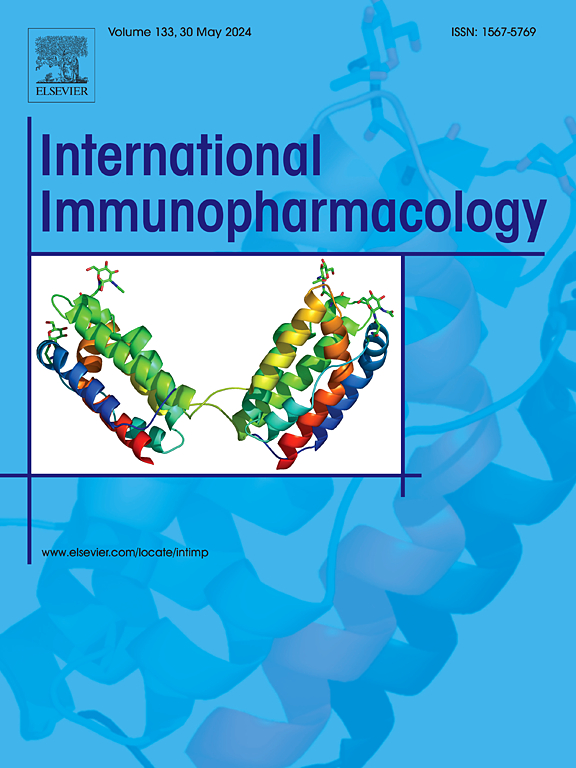靶向CFTR恢复聚集抑制HSC活化,减轻肝纤维化。
IF 4.7
2区 医学
Q2 IMMUNOLOGY
引用次数: 0
摘要
背景和目的:多项研究表明,肝纤维化是一种进行性疾病,是各种慢性肝病的终点,其主要特征是肝星状细胞(HSCs)的广泛活化。然而,囊性纤维化跨膜传导调节剂(CFTR)在肝纤维化发展过程中对hsc的确切影响尚不清楚。方法:在我们的研究中,我们测量了组织样本和TGF-β刺激激活的hsc中的CFTR水平。我们使用四氯化碳(CCl4)和胆管结扎(BDL)建立小鼠肝纤维化模型。体外实验中,我们通过探讨CFTR在造血干细胞中的聚集作用来研究CFTR作用的具体机制。我们采用共免疫沉淀(co-IP)实验来鉴定CFTR的潜在下游靶点。最后,通过救援实验,我们检测了gtpase激活蛋白结合蛋白1 (G3BP1)对cftr介导的肝星状细胞活化的影响。结果:在TGF-β诱导的活化hsc中,发现CFTR降低、多种肝纤维化模型和纤维化组织样本。体外功能实验证实,CFTR促进了hsc中纤维化相关标志物的表达和聚集。在机制上,我们发现CFTR直接与G3BP1相互作用,从而进一步促进TGF-β/Smad2/3通路。CFTR敲低引起的G3BP1抑制减少了细胞外基质沉积,有助于减轻肝纤维化。结论:我们强调CFTR通过靶向G3BP1,参与TGF-β/Smad2/3信号通路,激活吞噬,促进HSC活化和肝纤维化。总体而言,CFTR已被确定为肝纤维化的潜在治疗靶点。本文章由计算机程序翻译,如有差异,请以英文原文为准。
Targeting CFTR restoring aggrephagy to suppress HSC activation and alleviate liver fibrosis
Background and aims
Multiple studies have shown that hepatic fibrosis, a progressive condition that represents the endpoint of various chronic liver diseases, is primarily marked by the extensive activation of hepatic stellate cells (HSCs). However, the exact impact of cystic fibrosis transmembrane conductance regulator (CFTR) on HSCs during the development of hepatic fibrosis remains unclear.
Methods
In our study, we measured CFTR levels in tissue samples and in HSCs activated by TGF-β stimulation. We established mouse models of liver fibrosis using carbon tetrachloride (CCl4) and bile duct ligation (BDL). In vitro, we investigated the specific mechanisms of CFTR action in HSCs by exploring aggrephagy. We employed co-immunoprecipitation (co-IP) experiments to identify potential downstream targets of CFTR. Finally, through rescue experiments, we examined the impact of GTPase-activating protein − binding protein 1 (G3BP1) on CFTR-mediated activation of hepatic stellate cells.
Result
In activated HSCs induced by TGF-β, the reduction of CFTR, various liver fibrosis models, and fibrotic tissue samples were identified. In vitro functional experiments confirmed that CFTR promoted the expression of fibrosis-related markers and aggrephagy in HSCs. Mechanistically, we found that CFTR directly interacts with G3BP1, thereby further promoting the TGF-β/Smad2/3 pathway. The inhibition of G3BP1 caused by CFTR knockdown reduced extracellular matrix deposition, contributing to alleviating liver fibrosis.
Conclusion
We emphasize that CFTR activates aggrephagy and promotes HSC activation and hepatic fibrosis by targeting G3BP1, participating in the TGF-β/Smad2/3 signaling pathway. Overall, CFTR has been identified as a potential therapeutic target for liver fibrosis.
求助全文
通过发布文献求助,成功后即可免费获取论文全文。
去求助
来源期刊
CiteScore
8.40
自引率
3.60%
发文量
935
审稿时长
53 days
期刊介绍:
International Immunopharmacology is the primary vehicle for the publication of original research papers pertinent to the overlapping areas of immunology, pharmacology, cytokine biology, immunotherapy, immunopathology and immunotoxicology. Review articles that encompass these subjects are also welcome.
The subject material appropriate for submission includes:
• Clinical studies employing immunotherapy of any type including the use of: bacterial and chemical agents; thymic hormones, interferon, lymphokines, etc., in transplantation and diseases such as cancer, immunodeficiency, chronic infection and allergic, inflammatory or autoimmune disorders.
• Studies on the mechanisms of action of these agents for specific parameters of immune competence as well as the overall clinical state.
• Pre-clinical animal studies and in vitro studies on mechanisms of action with immunopotentiators, immunomodulators, immunoadjuvants and other pharmacological agents active on cells participating in immune or allergic responses.
• Pharmacological compounds, microbial products and toxicological agents that affect the lymphoid system, and their mechanisms of action.
• Agents that activate genes or modify transcription and translation within the immune response.
• Substances activated, generated, or released through immunologic or related pathways that are pharmacologically active.
• Production, function and regulation of cytokines and their receptors.
• Classical pharmacological studies on the effects of chemokines and bioactive factors released during immunological reactions.

 求助内容:
求助内容: 应助结果提醒方式:
应助结果提醒方式:


